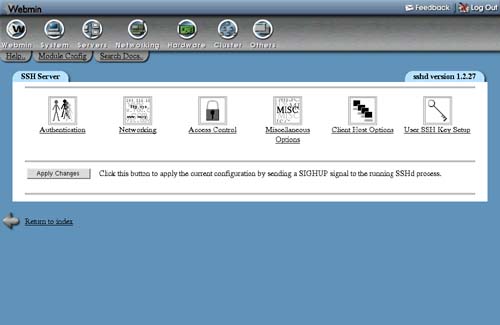42.2. The SSH Server Module
This chapter deals with the configuration of both the SSH and OpenSSH servers, and assumes that you have a basic user's knowledge of the client programs. The Webmin module that can be used to carry out this configuration is named SSH Server and can be found under the Servers category. Clicking on its icon will take you to the main page shown in Figure 42.1, assuming that the SSH package is installed.
Figure 42.1. The SSH Server module.

If an error message like The SSH server config file /etc/ssh/sshd_config was not found on your system appears instead, there is probably no SSH server installed on your system. Most modern Linux distributions come with an OpenSSH package, so check your distribution CD or website for any packages whose names start with openssh or ssh. Often there will be several, such as openssh, openssh-client, and openssh-server, all of which should be installed. You may also need to install the OpenSSL library as well, which should also be available in package form. Use the Software Packages module (covered in Chapter 12) to check for and install everything that is needed.
If no SSH package exists for your operating system, you will need to down download, compile, and install the OpenSSH or SSH source code. As you might expect, OpenSSH can be found at www.openssh.org/, while the original SSH can be downloaded from www.ssh.com/. Installing should be easy on any UNIX operating system, assuming you have a compiler avalable. The only dependency is an SSL library like OpenSSL, which can be downloaded from www.openssl.org/.
After installation, you should make sure that the SSH server will be started at boot time. Use the Bootup and Shutdown module (from Chapter 9) to create an action that runs the sshd command when started. If there is already an action named sshd or ssh-server, all you will need to do is make sure that it is enabled.
No matter how you install the SSH server, it should allow clients to log in and transfer files immediately using the default configuration once the server process is started. In fact, on a typical system, very little configuration is needed at all as the defaults are suitable for the average server.
The two different SSH implementations and their many versions all have slightly different configuration file formats, to which the module needs to adapt itself. This means that the forms and fields that make up its user interface are not always the same, depending on the version and type of server that you have installed. The instructions and screenshots in this chapter have been written with OpenSSH version 2.5 in mind, but any differences or extra features that other SSH versions have will be mentioned as well.
The main page will always display six icons, under each of which is a form containing fields for setting options related to some category—such as authentication or networking. At the top, the implementation and version of the installed SSH is displayed so you can see which of the instructions in this chapter apply to your system. At the bottom is a button labeled Apply Changes, which, when clicked, signals the SSH server to reread its configuration file. No changes made in the module will take effect until you hit this button.
